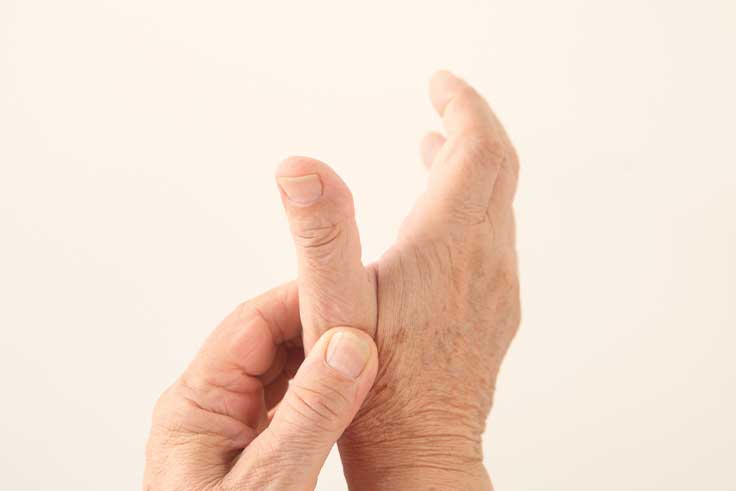What is arthritis in the base of the thumb?
The base of the thumb is where the thumb joins up with the wrist. The main joint involved in arthritis at the base of the thumb is the trapeziometacarpal joint (also known as the carpometacarpal joint – CMC joint of the thumb).
This joint is formed by a long bone in the thumb called the metacarpal and a bone in the wrist called the trapezium. This joint provides the majority of the useful motion in your hand – gripping, pinching, twisting, opening jars, and writing all require this joint to have pain-free function. Arthritis may cause pain with all these activities.
This type of arthritis is more common in women than men, and usually doesn’t happen before age 40. Fractures and other trauma to the thumb joint may put you at risk for developing arthritis in the future.
What are the signs and symptoms of basilar thumb arthritis?
Some patients with arthritis at the base of the thumb never have symptoms. Others have crippling and severe pain at an early age.
The earliest symptom of thumb arthritis is pain at the base of the thumb (the heel of the palm) with pinching, opening jars, or after long periods of writing. Turning keys or opening doorknobs may also be painful.
Weather changes (such as before it rains) may create pain in the thumb. Heavy repetitive use may also cause deep aching in the thumb. As arthritis gets worse, the strength of pinching gets weaker and heavy activity is no longer required to make the thumb painful.
Patients with advanced arthritis may feel a grinding/crunching sensation with even small movements of the thumb, and the thumb joint may start to look enlarged, swollen, or “out of place”. The joint at the base of the thumb becomes very stiff at this point.
Other joints further out towards the tip of the thumb may become looser and more deformed to compensate for the stiffness at the thumb base.
How is thumb arthritis diagnosed?
Arthritis at the base of the thumb is diagnosed by history (the story of how symptoms develop) and physical examination.
The base joint (CMC joint) is tender to touch and you can often feel crunching or grinding as the joint is moved in a circular pattern. Swelling is usually present around the joint.
Other conditions in the same area may cause a similar appearance, such as tendonitis and arthritis in other joints of the wrist and thumb.
X-rays are useful for confirming the specific joint involved with arthritis, though the appearance of the joint on x-ray may not match how the patient feels.
There are several x-ray views ordered by your hand surgeon that show arthritis more clearly than those ordered by your family doctor. These additional views are especially helpful in mild cases, where the diagnosis isn’t obvious on regular x-rays of the hand or wrist.
The swelling, tenderness, or abnormal motion of other joints nearby may also reinforce the diagnosis of arthritis at the base of the thumb.
Can thumb arthritis pain be treated?
Arthritis at the base of the thumb is treated like arthritis elsewhere in the body:
– limited motion or use
– splinting (click here to see the best splint for thumb arthritis)
– anti-inflammatory medicine (pills or creams
– heat therapy (warm/hot water soaks)
– Cortisone (steroid) injections in the joint may give some significant relief for several months. This can be done along with the above methods or after they have failed to provide pain relief.
After non-surgical treatments fail to provide adequate pain relief, surgery should be considered.
Surgery for CMC arthritis involves removing the arthritic portion of the joint (some or all of the trapezium bone) and replacing it with a tendon to serve as a cushion between the bones. Joint replacement with artificial joints is also an option for worn-out CMC joints in the thumb – we can talk about this option in greater detail in the office.
Many patients read about or watch YouTube videos on a surgery called an LRTI (ligament replacement tendon interposition), which is a close cousin of the surgery I do.
This surgery is done as an outpatient procedure (have the surgery and go home the same day) under a general anesthetic or arm nerve block. The thumb is placed in a splint or cast for six weeks and therapy (stretching and strengthening at home) is started during the second six weeks. The fingers are left free during recovery.
Total recovery time ranges from two to three months. Most patients return to unlimited use of the thumb three months after surgery.

